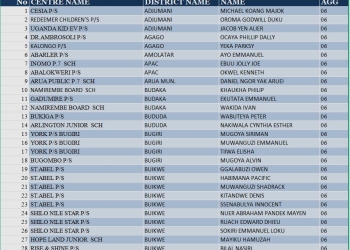
KAMPALA, Uganda— The Ugandan government has issued stringent new standards for nursery schools, set to take immediate effect as schools prepare to reopen for the second term next week. These comprehensive guidelines, the first specifically for pre-primary education, aim to enhance the quality of early childhood learning across the country.
Among the key changes, the teacher-to-learner ratio has been revised from 1:40 to a maximum of 1:25, meaning each nursery teacher will now be responsible for no more than 25 children. Class sizes have also been capped at 25 learners. Additionally, the school day for nursery pupils has been restructured, with children expected to report at 8 a.m. and be picked up by 12:30 p.m., a schedule that includes both learning and break time.
These reforms are part of the Pre-Primary Basic Requirements and Minimum Standards framework, developed by the Ministry of Education and Sports. Previously, nursery schools operated under standards designed for primary and secondary institutions. The new standards have been approved and signed by First Lady and Minister for Education and Sports, Janet Museveni, and are currently being printed for nationwide distribution.
Frances Atima, the director for education standards at the education ministry, said the new framework aims to ensure quality, consistency and equitable access to early childhood education. She noted that the pre-primary sector has faced challenges including inadequate licensing and registration, disparities in infrastructure, limited access and a shortage of qualified teachers.
According to ministry data, only 10% of the 28,208 operational pre-primary schools are registered, and 30% are licensed, hindering quality oversight. Atima highlighted the “wide variability in the quality of pre-primary schools” and emphasized the urgent need for robust standards to ensure “a more consistent and equitable learning environment for all children”.
About half of pre-primary teachers have relevant training, while 18% lack formal qualifications. Enrollment for children aged three to five remains low at 16.6%, with a significant 51% enrollment gap between the highest and lowest income groups. Furthermore, 63% of enrolled children live in urban areas, underscoring an urban-rural divide.
Hasadu Kirabira, the national chairperson of the National Private Education Institutions Association (NPEIA), welcomed the guidelines, particularly the requirement for formal employment contracts for both teaching and support staff, which he said will help formalize the sector. However, Kirabira requested more time for full compliance, especially regarding teacher qualifications, stating that “just a handful of them have these certificates”. He also expressed concern that capping class sizes at 25 pupils would be difficult to implement in existing “standard classrooms” designed for more learners.
On adjusted school hours, Kirabira noted that while schools can comply, parents will need more sensitization regarding drop-off and pick-up times, as many bring children early and pick them up late due to work schedules.
The new standards follow the Cabinet’s approval of the Early Childhood Care and Education (ECCE) Policy last year and the development of a new curriculum for nursery schools. Under the ECCE policy, only children aged three and above are eligible for the three-year nursery program. The new curriculum adjusts class hours to run from 8:30 a.m. to 12:30 p.m., including breaks, and eliminates homework for nursery pupils, with all learning activities to be completed during school hours.
Developed by the National Curriculum Development Centre (NCDC), the new curriculum replaces the Learning Framework for Early Childhood Development (ECD), in use since 2005. It expands learning areas from five to seven and introduces cursive handwriting, known locally as “kanana munana,” at the nursery level to enhance brain development, concentration and writing skills. Learning will be delivered through a play-based approach, focusing on life skills, social skills and holistic child development.
The new standards also emphasize a safe and stimulating physical environment, requiring schools to be fenced off from the public, provide outdoor green spaces free of tripping hazards, and ensure indoor spaces allocate a minimum of 1.5 square meters per child. Schools must be located away from industrial zones and shielded from hazards. All buildings must be structurally sound with safety features like lightning arresters, firefighting equipment and emergency exits, and include designated areas for arts, music, play, reading, writing and drawing.

















